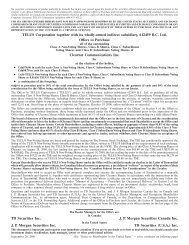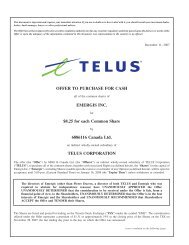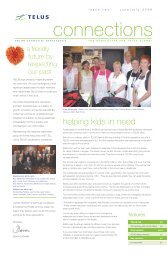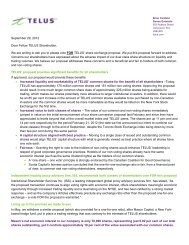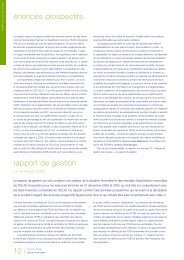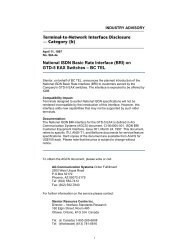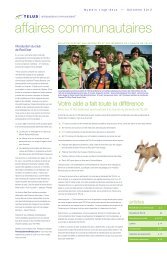Annual report - About TELUS
Annual report - About TELUS
Annual report - About TELUS
You also want an ePaper? Increase the reach of your titles
YUMPU automatically turns print PDFs into web optimized ePapers that Google loves.
Qexpect for acquisitions in the future?<br />
A<br />
Following the acquisitions of Clearnet and 70% of QuébecTel, what can we<br />
Q A> Third Generation (3G) describes next generation wireless technology that is expected to<br />
be CDMA-based and offer high-speed packet data mobile wireless Internet access and multimedia<br />
communications. Globally 3G services largely remain in the development phase and, in Canada,<br />
additional spectrum for 3G is not expected to be allocated until the 2003 to 2004 time frame.<br />
What is <strong>TELUS</strong>’ strategy to offer 3G wireless services?<br />
one team > one brand > one strategy<br />
> 34<br />
> Possible future acquisition activity is expected to be substantially related to the expansion<br />
of the development and distribution of our data and IP capabilities on a national basis, enabling us<br />
to exploit the expected growth in Enhanced Data markets.<br />
Any possible acquisitions in this area would likely be smaller than the QuébecTel purchase of almost<br />
$600 million and could be funded in part with non-cash consideration.<br />
<strong>TELUS</strong> Mobility currently offers 2G services on a digital CDMA technology platform which offers<br />
circuit data speeds of up to 14.4 kbps. While first Generation refers to analogue cellular, developed<br />
prior to 2G digital, 2.5G refers to the first implementation of packet data capability on existing digital<br />
networks, or the migration step from 2G to 3G. 3G has become synonymous with packet data<br />
rates of a minimum of 384 kbps on a mobile basis and 2.048 mbps on a fixed basis.<br />
<strong>TELUS</strong> Mobility’s ESMR Mike product, based on an iDEN technology platform supplied by Motorola,<br />
already operates on a packet data network which offers shared data speeds of up to 19.2 kbps.<br />
On its CDMA2000 based, PCS network, <strong>TELUS</strong> Mobility is in the process of implementing the first<br />
step in the CDMA2000 3G evolution path. This is known as 1XRTT which is expected to offer<br />
packet data speeds of up to 144 kbps and offer nearly double the voice capacity of its current IS-95<br />
CDMA based systems. This service offering is dependent on the commercial availability of 1XRTT<br />
handsets. While uncertain, this is anticipated in late 2001 or early 2002.<br />
Over 56% of <strong>TELUS</strong> Mobility’s digital subscriber base is equipped with browser capable handsets.<br />
During the course of 2000, <strong>TELUS</strong> Mobility introduced wireless Internet services and continues to<br />
broaden their scope. <strong>TELUS</strong> Mobility currently offers subscribers a rich variety of wireless Internet<br />
services, such as two-way e-mail, directories, news and information services, stock quotes, and<br />
banking and financial transaction related services. While 3G is expected to enhance the range of<br />
services that we will be able to offer, such as high-speed, multimedia applications, it has not been<br />
necessary to wait for the development of 3G to begin offering a multitude of value-added Internet<br />
services. To date, <strong>TELUS</strong> Mobility’s offering has been met by strong consumer response.<br />
In addition to this solid springboard from which to introduce next generation wireless services,<br />
<strong>TELUS</strong> Mobility has already been installing base stations which adhere to the CDMA2000 3G<br />
evolution path. <strong>TELUS</strong> Mobility expects to have its switching and Internet related CDMA infrastructure<br />
upgraded by the end of 2001, and also anticipates its cell site CDMA infrastructure to be substantially<br />
1XRTT capable by year-end.


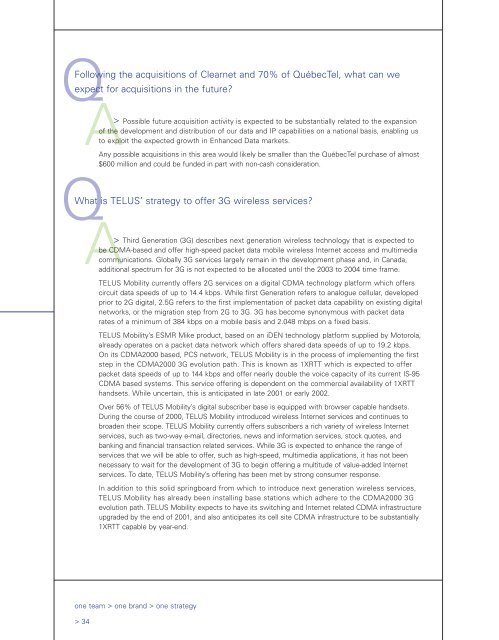
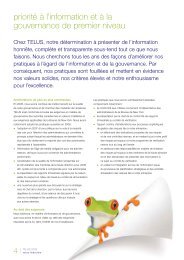
![DISK004:[98CLG6.98CLG3726]BA3726A.;28 - About TELUS](https://img.yumpu.com/16786670/1/190x245/disk00498clg698clg3726ba3726a28-about-telus.jpg?quality=85)
